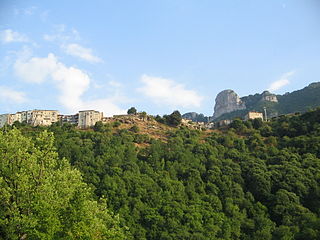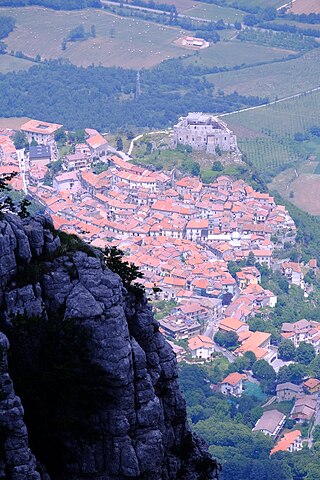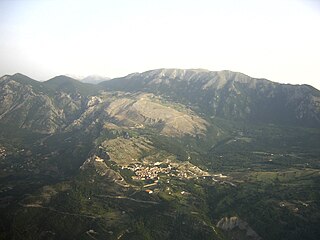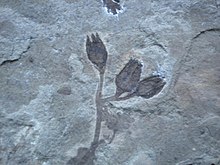
Auletta is a town and comune in the province of Salerno in the Campania region of south-western Italy.

Petina is a town and comune in the province of Salerno in the Campania region of south-western Italy.

Sant'Angelo a Fasanella is a town and comune in the province of Salerno in the Campania region of south-western Italy.

Sicignano degli Alburni is a town and comune in the province of Salerno in the Campania region of southern Italy.

Sergestidae is a family of prawns which have lived since at least the Middle Jurassic (Bajocian/Bathonian). It contains the following genera:

Cilento, Vallo di Diano and Alburni National Park is an Italian national park in the Province of Salerno, in Campania in southern Italy. It includes much of the Cilento, the Vallo di Diano and the Monti Alburni. It was founded in 1991, and was formerly known as the Parco Nazionale del Cilento e Vallo di Diano.

Chirocentrites is an extinct genus of marine ray-finned fish in the order Ichthyodectiformes. It contains a single species, C. coroninii, from the Late Cretaceous (Cenomanian) of Slovenia. A potential specimen is also known from the Albian-aged Pietraroja Plattenkalk of southern Italy, but it has been suggested that this specimen actually represents Cladocyclus.

Archaeoniscus is a genus of prehistoric isopods that first appeared during the Bajocian stage of the Middle Jurassic. It is a widespread genus with a paleogeographic distribution encompassing the continental margin environments of the central Atlantic Ocean and the western Tethys Ocean. Fossils of Archaeoniscus suggest that this genus lived in diverse aquatic habitats, including the marine, paralic, and freshwater environments. While earlier descriptions suggested that it may have had an ectoparasitic association with fishes, some researchers argue that at least two species, A. aranguthyorum and A. coreaensis, lived a benthic free-living lifestyle based on morphological characteristics that are either unsuitable for or unrelated to parasitic behavior.
Caeus is an extinct genus of prehistoric marine ray-finned fish, closely related to the modern milkfish. It contains a single species, C. leopoldi from the Early Cretaceous of the Pietraroja Plattenkalk, Italy. It is one of the largest teleosts known from the Pietraroja formation, and is known by only a single specimen.

The Pietraroia Plattenkalk is a Cretaceous geologic formation located in the Italian municipality of Pietraroja, near Benevento, in Campania region. It is of Albian age. Dinosaur remains diagnostic to the genus level are among the fossils that have been recovered from the formation and the type locality of the formation is the La Cavere quarry, which is near the village of Pietraroja.

Acanthochirana is an extinct genus of prawn that existed during the upper Jurassic period. It was named by E. Strand in 1928, and its type species is Acanthochirana cordata. They are distinguished from the related genus Aeger by the presence of teeth on the rostrum, which are absent in Aeger.
Acanthinopus gibbosus is an extinct species of shrimp placed in its own genus, Acanthinopus, which has not been assigned to a family. It was found in Norian sediments of the Zorzino Limestone in northern Italy.
Bechleja is an extinct genus of shrimp which existed during the Eocene period. It contains four species.

The Alburni are an Italian mountain range of the Province of Salerno, Campania, part of the Apennines. Due to their geomorphology, they are popularly known as the "Dolomites of Campania" or of Southern Italy. The highest mountain is the Panormo. Its second name, Alburno, gives the name to the whole range.
The Cilentana Nera is an indigenous breed of domestic goat from the province of Salerno, in Campania in southern Italy. It takes its name from the geographical region of the Cilento, much of which is today within the Parco Nazionale del Cilento, Vallo di Diano e Alburni, and is raised mainly in that area and in the Monti Alburni. The range extends to the Monti Picentini and to the area of Ricigliano in eastern Campania and Muro Lucano in Basilicata. It is one of three goat breeds in the Cilento, the others being the Cilentana Grigia and the Cilentana Fulva. The Cilentana Nera is found on higher ground and poorer pasture than the other two, and is raised mainly for meat. It has been influenced by the Garganica and Napoletana goat breeds.
The Cilentana Fulva is an indigenous breed of domestic goat from the province of Salerno, in Campania in southern Italy. It takes its name from the geographical region of the Cilento, much of which is today within the Parco Nazionale del Cilento, Vallo di Diano e Alburni, and is raised in that area, in the Monti Picentini, and throughout the province of Salerno. It is one of three indigenous goat breeds in the Cilento, the others being the Cilentana Grigia and the Cilentana Nera. The Cilentana Fulva is found on lower ground and richer pasture than the Cilentana Nera, and is raised mainly for milk. It appears to derive from inter-breeding of local goats with the Maltese and particularly the Derivata di Siria, with which it shares many characteristics.
The Cilentana Grigia is an indigenous breed of domestic goat from the province of Salerno, in Campania in southern Italy. It takes its name from the geographical region of the Cilento, much of which is today within the Parco Nazionale del Cilento, Vallo di Diano e Alburni, and is raised mainly in that area, but also in the Monti Alburni and the Monti Picentini. It is one of three indigenous goat breeds in the Cilento, the others being the Cilentana Fulva and the Cilentana Nera. The Cilentana Grigia is found on lower ground and richer pasture than the Cilentana Nera, and is raised mainly for milk. The origins of the breed are obscure; it shows the influence of the Maltese and Garganica breeds, and similarities to other Italian grey breeds such as the Ciociara Grigia of Lazio and the Argentata dell'Etna from Sicily.

Kunbarrasaurus is an extinct genus of small ankylosaurian dinosaur from the Cretaceous of Australia. The genus conatins a single species, K. ieversi.

Leyvachelys is an extinct genus of turtles in the family Sandownidae from the Early Cretaceous of the present-day Altiplano Cundiboyacense, Eastern Ranges, Colombian Andes. The genus is known only from its type species, Leyvachelys cipadi, described in 2015 by Colombian paleontologist Edwin Cadena. Fossils of Leyvachelys have been found in the fossiliferous Paja Formation, close to Villa de Leyva, Boyacá, after which the genus is named. The holotype specimen is the oldest and most complete sandownid turtle found to date.

Eichstaettisaurus is a genus of lizards from the Late Jurassic and Early Cretaceous of Germany, Spain, and Italy. With a flattened head, forward-oriented and partially symmetrical feet, and tall claws, Eichstaettisaurus bore many adaptations to a climbing lifestyle approaching those of geckoes. The type species, E. schroederi, is among the oldest and most complete members of the Squamata, being known by one specimen originating from the Tithonian-aged Solnhofen Limestone of Germany. A second species, E. gouldi, was described from another skeleton found in the Matese Mountains of Italy. Despite being very similar to E. schroederi, it lived much later, during the Albian stage. Fossils of both species show exceptional preservation due to deposition in low-oxygen marine environments.














